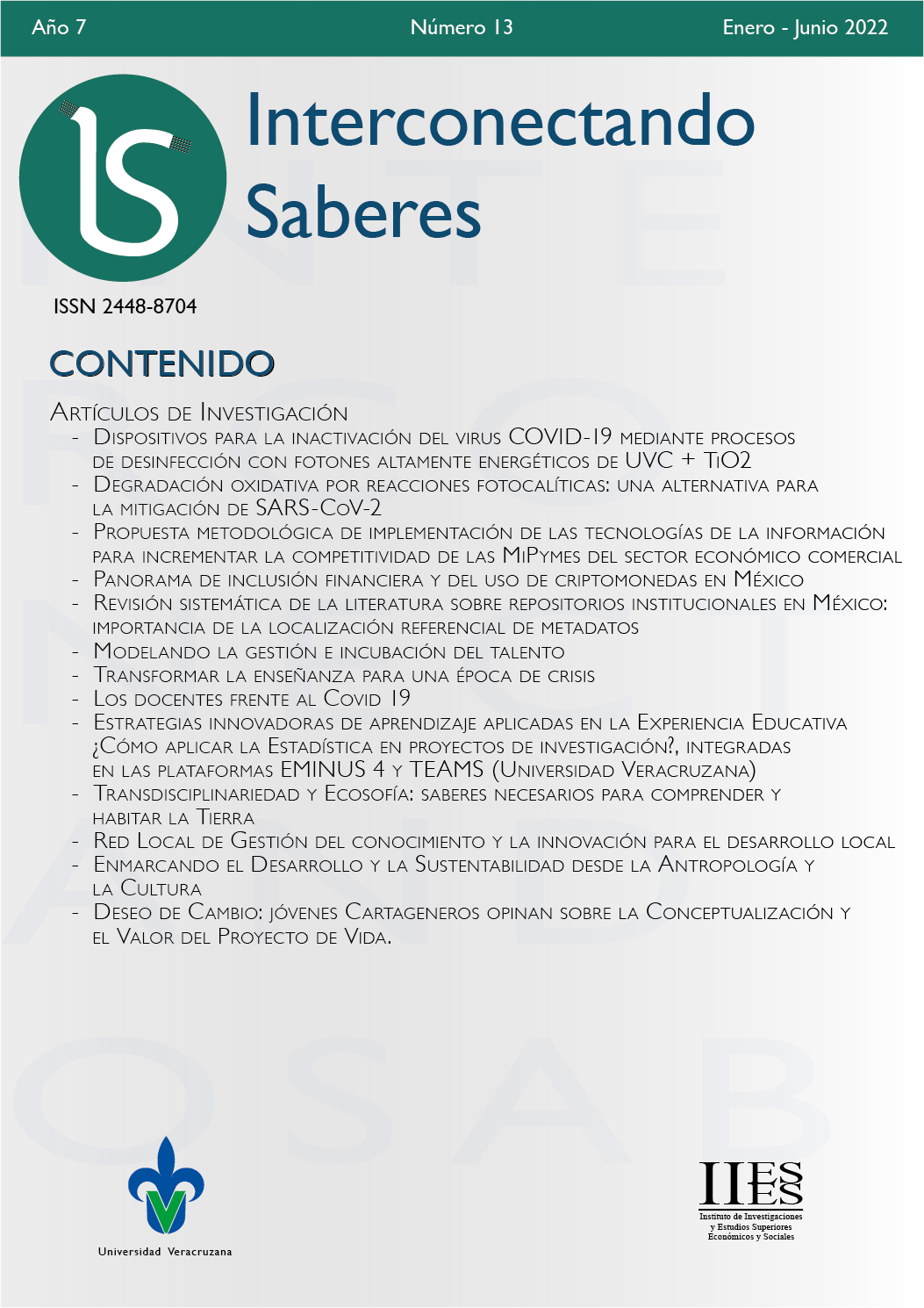Abstract
Photocatalysis is a chemical reaction induced by the absorption of a solid material, or photocatalyst. The excitation of the solid triggers two reactions that lead to the almost instantaneous formation of hydroxyl radicals and superoxide anions (called reactive oxygen species; ROS). ROS produce oxidative damage in various microorganisms including the SARS-CoV2 virus, favoring the disintegration of the protein conformation of the capsid, changes in permeability and damage to the virion membrane that ultimately leads to DNA breakage, without the opportunity for repair. Even the photocatalytic reaction causes oxidative degradation against organic and/or inorganic hazardous materials in the air to convert them into non-harmful substances such as water or carbon dioxide.
References
Bedrosian, N., Mitchell, E., Rohm, E., Rothe, M., Kelly, C., String, G., Lantagne, D. (2020). A Systematic Review of Surface Contamination, Stability, and Disinfection Data on SARS-CoV-2. Environmental Science and Technology, 55 (7), 4162–4173. https://doi.org/10.1021/acs.est.0c05651
Bono, N., Ponti, F., Carlo, P., Gabriele, C. (2021). Effect of UV Irradiation and TiO2 Photocatalysis on Airborne Bacteria and Viruses: An Overview. Materials, 14 (5), https://doi.org/10.3390/ma14051075
Effendi, A. (2019). Enhancing Bioremediation of Crude Oil Contaminated Soil by Combining With Photocatalytic Process Using TiO2 as Catalyst. International Journal of Geomate, 17 (64), 100-107. https://doi.org/10.21660/2019.64.46068
Heilingloh, C., Wilhelm, U., Schipper, L., Dittmer, U., Witzke, O., Yang, D., Zheng, X., Sutter, L., Trilling, M., Alt, M., Steinmann, E., Krawczyk, A. (2020). Susceptibility of SARS-CoV-2 to UV irradiation, American Journal of Infection Control, 48 (10), 1273-1275. https://doi.org/10.1016/j.ajic.2020.07.031
Khaiboullina, S., Uppal, T., Dhabarde, N., Subramanian, V. R., Verma, S. C. (2020). Inactivation of Human Coronavirus by Titania Nanoparticle Coatings and UVC Radiation: Throwing Light on SARS-CoV-2. Viruses, 13(1), 19. https://doi.org/10.3390/v13010019
Matsuura, R., Lo, C., Wada, S., Somei, J., Ochiai, H., Murakami, T., Sairo, N., Ogawa, T., Shinjo, A., Benno, Y., Nakagawa, M., Takei, M., Aida, Y. (2021). SARS-CoV-2 Disinfection of Air and Surface Contamination by TiO2 Photocatalyst-Mediated Damage to Viral Morphology, RNA, and Protein. Viruses, 13 (5), 942. doi: https://doi.org/10.3390/v13050942
Muangmora, R., Kemacheevakul, P., Chuangchote, S. (2021). Titanium Dioxide and its Modified Forms as Photocatalysts for Air Treatment. Current Analytical Chemistry, 17 (2), 185-201. https://doi.org/10.2174/1573411016666200131130152
Nakano, R., Ishiguro, H., Yao, Y., Kajioka, J., Fujishima, A., Sunada, K., Minoshima, M., Hashimoto, K., Kubota, Y. (2012). Photocatalytic inactivation of influenza virus by titanium dioxide thin film. Photochemistry and Photobiology, 11, 1293–1298. https://doi.org/10.1039/c2pp05414k
Ong, S.W., Tan, Y.K., Chia, P.Y., Lee, T.H., Ng, O.T., Wong, M.S., Marimuthu, K. A. (2020). Surface Environmental, and Personal Protective Equipment Contamination by Severe Acute Respiratory Syndrome Coronavirus 2 (SARS-CoV-2) From a Symptomatic Patient. JAMA, 28;323(16):1610-1612. https://doi.org/10.1001/jama.2020.3227
Sun, Y., Li, J., Xia, L. (2016). Precise Genome Modification via Sequence Specific Nucleases-Mediated Gene Targeting for Crop Improvement. Frontiers in Plant Science, 7, 1928. https://doi.org/10.3389/fpls.2016.01928
Syngouna, V.I., Chrysikopoulos, C.V. (2017). Inactivation of MS2 bacteriophage by titanium dioxide nanoparticles in the presence of quartz sand with and without ambient light. Journal of Colloid and Interface Science, 497, 117–125. https://doi.org/10.1016/j.jcis.2017.02.059
Talaiekhozani, A., Rezania, S., Hyun K., Sanaye, R., Mohammad, A. (2021). Recent advances in photocatalytic removal of organic and inorganic pollutants in air. Journal of Cleaner Production, 278, 23895. https://doi.org/10.1016/j.jclepro.2020.123895
Tang, S., Mao, Y., Jones, RM, Tan, Q., Ji, JS, Li, N., Shen, J., Lv, Y., Pan, L., Ding, P., Wang, X., Wang, Y., MacIntyre, CR., Shi, X. (2020). ¿Aerosol transmission of SARS-CoV-2? Evidence, prevention, and control. Environment International, 144, 106039. https://doi.org/10.1016/j.envint.2020.106039
Tong, Y., Shi, G., Hu, G., Hu, X., Han, L., Xie, X., Xu, Y., Zhang, R., Sun, J., Zhong, J. (2021). Photo-catalyzed TiO2 inactivates pathogenic viruses by attacking viral genome. Chemical Engineering Journal, 414, 128788. https://doi.org/10.1016/j.cej.2021.128788
Xuekai, S., Jie, B., Dianbo, D, Zhiping, F. (2021). UV Assisted Photocatalytic Remediation of Polycyclic Aromatic Hydrocarbons (Pahs) in Sewage Sludge Addition Soils Using Synthesized Nanometer Mixed-crystal TiO2: Experiment and Simulation. Soil and Sediment Contamination: An International Journal, https://doi.org/10.1080/15320383.2021.1981822

This work is licensed under a Creative Commons Attribution-NonCommercial-NoDerivatives 4.0 International License.
Copyright (c) 2022 Miguel Lara Castro, Yessica Bautista Bautista, Rosa María Woo García, Ana Carem Bonilla Hernández

